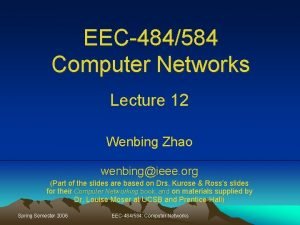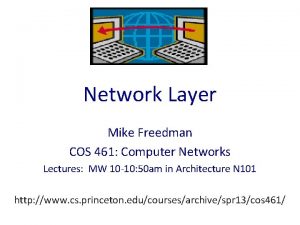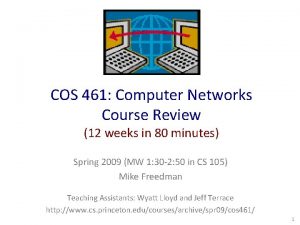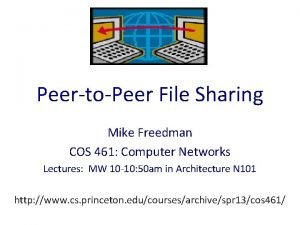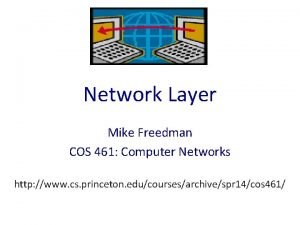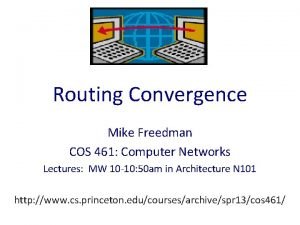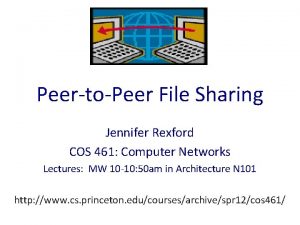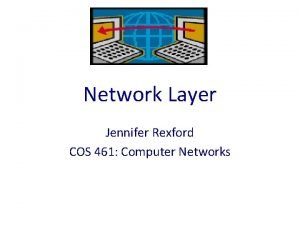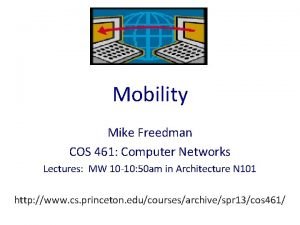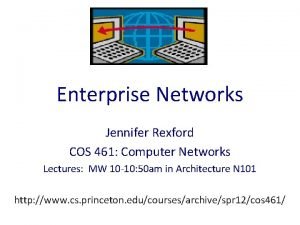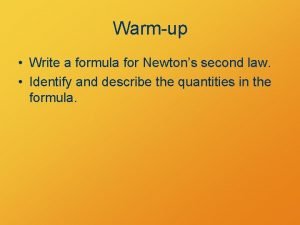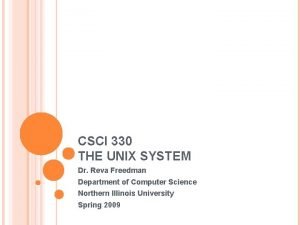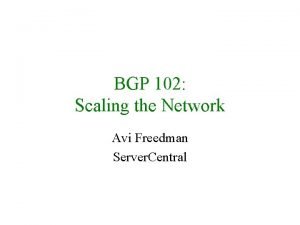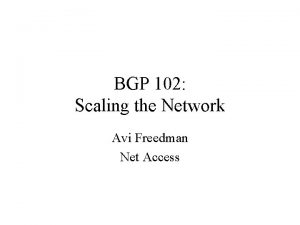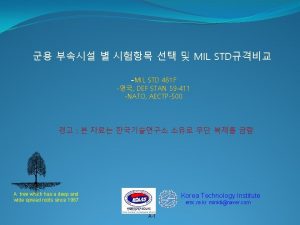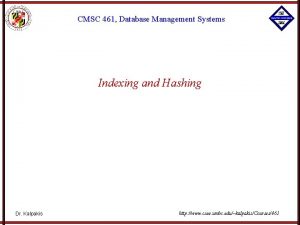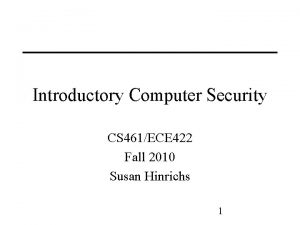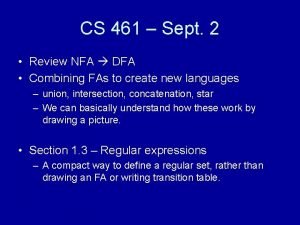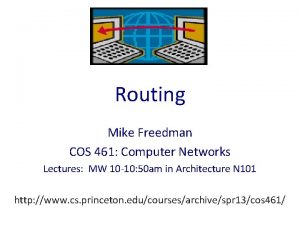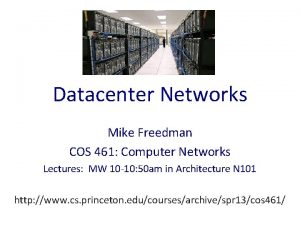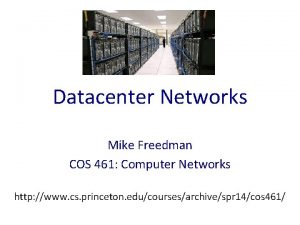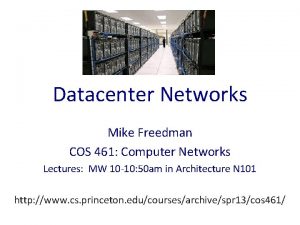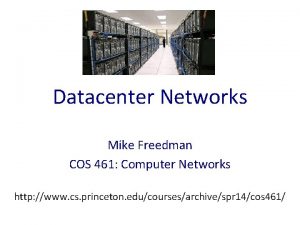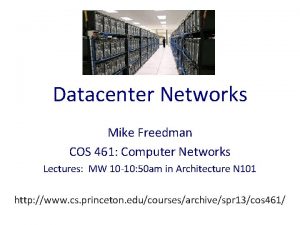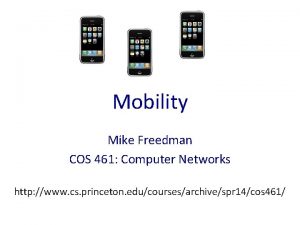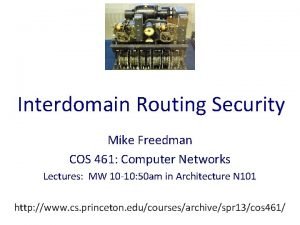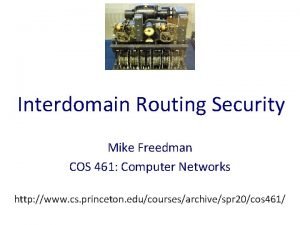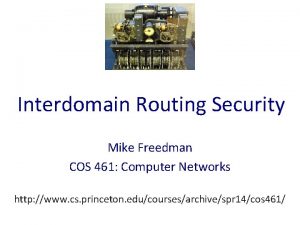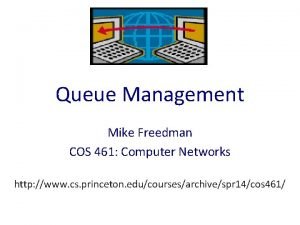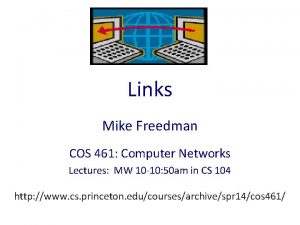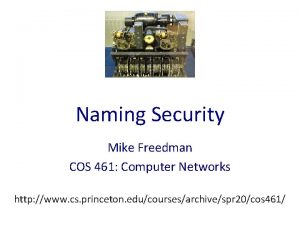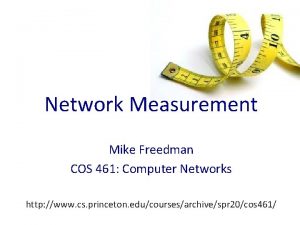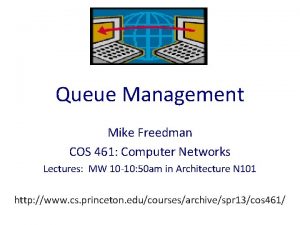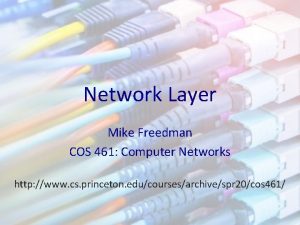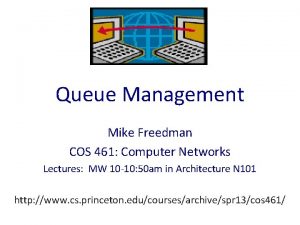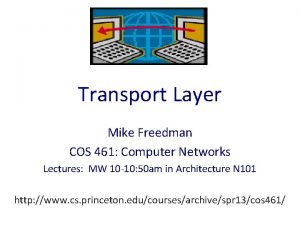Routing Mike Freedman COS 461 Computer Networks http



































- Slides: 35

Routing Mike Freedman COS 461: Computer Networks http: //www. cs. princeton. edu/courses/archive/spr 14/cos 461/

Routing: Mapping Link to Path logical link physical path name address 2

Data and Control Planes data plane Processor Line card control plane Line card Switching Fabric Line card 3

Three Issues to Address • What does the protocol compute? – E. g. , shortest paths • What algorithm does the protocol run? – E. g. , link-state routing • How do routers learn end-host locations? – E. g. , injecting into the routing protocol 5

What Does the Protocol Compute? 6

Different Types of Paths • Static model – What is computed, not how computation performed • Trade-offs – State to represent the paths – Efficiency of the paths – Ability to support multiple paths – Complexity of path computation 7

Spanning Tree • One tree that reaches every node – Single path between each pair of nodes – No loops, so can support broadcast easily – But, paths are long, and some links not used 8

Shortest Paths • Shortest path(s) between pairs of nodes – A shortest-path tree rooted at each node – Min hop count or min sum of edge weights – Multipath routing is limited to Equal Cost Multi. Path 9

Locally Policy at Each Hop • Locally best path – Local policy: each node picks the path it likes best – … among the paths chosen by its neighbors 2 3 2 d 3 4 d 5 4 d 2 1 d 2 d 1 1 d 1 2 d 4 5 6 6 4 d d 6 5 4 d Is (3 2 d) chosen path? (A) True (B) False 10

Locally Policy at Each Hop • Locally best path – Local policy: each node picks the path it likes best – … among the paths chosen by its neighbors 2 3 2 d 3 4 d 5 4 d 2 1 d 2 d 1 1 d 1 2 d 4 5 6 6 4 d d 6 5 4 d 3 2 d 3 4 d 3 5 4 d 5 2 4 d 2 1 d 2 d 1 1 d 1 2 d 4 6 4 d d 6 6 5 4 d 11

End-to-End Path Selection • End-to-end path selection – Each node picks its own end to end paths – … independent of what other paths other nodes use – More state and complexity in the nodes 12

How to Compute Paths? 13

Spanning Tree Algorithm root • Elect a root – The switch with the smallest identifier – And form a tree from there • Algorithm One hop – Repeatedly talk to neighbors • “I think node Y is the root” • “My distance from Y is d” Three hops Used in Ethernet LANs – Update based on neighbors • Smaller id as the root • Smaller distance d+1 14

Spanning Tree Example: Switch #4 1 • Switch #4 thinks it is the root – Sends (4, 0, 4) message to 2 and 7 3 5 • Switch #4 hears from #2 2 4 – Receives (2, 0, 2) message from 2 – Thinks #2 is root and it’s one hop away 7 6 • Switch #4 hears from #7 – Receives (2, 1, 7) from 7 – But, this is a longer path, so 4 prefers 4 -2 over 4 -7 -2 – And removes 4 -7 link from the tree 15

Shortest-Path Problem • Compute: path costs to all nodes – From a given source u to all other nodes – Cost of the path through each outgoing link – Next hop along the least-cost path to s 2 3 u 2 6 1 1 4 1 5 4 3 s 16

Link State: Dijkstra’s Algorithm • Flood the topology information to all nodes • Each node computes shortest paths to other nodes Initialization S = {u} for all nodes v if (v is adjacent to u) D(v) = c(u, v) else D(v) = ∞ Loop add w with smallest D(w) to S update D(v) for all adjacent v: D(v) = min{D(v), D(w) + c(w, v)} until all nodes are in S Used in OSPF and IS-IS 17

Link-State Routing Example 2 3 2 1 1 4 4 5 3 1 1 4 1 5 4 1 1 1 2 3 2 2 3 5 4 3 2 3 2 1 1 1 4 4 5 3 18

Link-State Routing Example (cont. ) 2 3 2 1 1 4 4 5 3 1 1 4 1 5 4 1 1 1 2 3 2 2 3 5 4 3 2 3 2 1 1 1 4 4 5 3 19

Link State: Shortest-Path Tree • Shortest-path tree from u 2 v 3 u 1 2 1 w 4 y 1 4 x 5 s z t 3 • Forwarding table at u dest link v w x y z s t (u, v) (u, w) 20

Link State: Shortest-Path Tree Find shortest path t to v v 1 4 u 4 3 1 w 1 y 1 1 x 5 s 2 t • Forwarding table entry at t (B) (t, s) z (A) (t, x) • Distance from t to v (A) 6 (B) 7 (C) 8 (D) 9 • Rounds to find shortest path (A) 5 (B) 6 (C) 7 (D) 8 21

Distance Vector: Bellman-Ford Algo • Define distances at each node x – dx(y) = cost of least-cost path from x to y • Update distances based on neighbors – dx(y) = min {c(x, v) + dv(y)} over all neighbors v 2 v 3 u 1 2 1 w 4 y 1 4 x 5 s du(z) = min{ c(u, v) + dv(z), c(u, w) + dw(z)} z t Used in RIP and EIGRP 3 22

Distance Vector Example 2 v 3 u 1 2 1 w 4 y 1 3 4 x z 5 s dy(z) = 1 dx(z) = 4 2 v u 1 2 1 t 3 w 4 y 1 4 x z 5 s t 3 dv(z) = min{ 2+dy(z), 1+dx(z) } =3 23

Distance Vector Example (Cont. ) 2 v 3 u 1 2 1 w 4 y 1 3 4 x z 5 s 2 v u 1 2 1 t 3 dw(z) = min{ 1+dx(z), 4+ds(z), 2+du(z) } =5 w 4 y 1 4 x z 5 s t 3 du(z) = (A) 5 (B) 6 (C) 7 24

Distance Vector Example (Cont. ) 2 v 3 u 1 2 1 w 4 y 1 3 4 x z 5 s 2 v u 1 2 1 t 3 dw(z) = min{ 1+dx(z), 4+ds(z), 2+du(z) } =5 w 4 y 1 4 x z 5 s t 3 du(z) = min{ 3+dv(z), 2+dw(z) } =6 25

Path-Vector Routing • Extension of distance-vector routing – Support flexible routing policies • Key idea: advertise the entire path – Distance vector: send distance metric per dest d – Path vector: send the entire path for each dest d 3 “d: path (2, 1)” “d: path (1)” 1 2 data traffic Used in BGP data traffic d 26

Path-Vector: Flexible Policies • Each node can apply local policies – Path selection: Which path to use? – Path export: Which paths to advertise? Node 2 prefers “ 2, 3, 1” over “ 2, 1” 2 3 1 Node 1 doesn’t let 3 hear the path “ 1, 2” 2 3 1 27

End-to-End Signaling • Establish end-to-end path in advance – Learn the topology (as in link-state routing) – End host or router computes and signals a path • Signaling: install entry for each circuit at each hop • Forwarding: look up the circuit id in the table 1 1: 7 2: 7 link 7 1: 14 2: 8 link 14 link 8 2 Used in MPLS with RSVP 28

Source Routing • Similar to end-to-end signaling – But the data packet carries the hops in the path • End-host control – Tell the end host the topology – Let the end host select the end-to-end path • Variations of source routing – Strict: specify every hop – Loose: specify intermediate points • Used in IP source routing (but almost always disabled) 29

Learning Where the Hosts Are 30

Finding the Hosts • Building a forwarding table – Computing paths between network elements – … and figuring out where the end-hosts are • How to find the hosts? – Learning/flooding – Injecting into the routing protocol – Dissemination using a different protocol – Directory service 31

Learning and Flooding • When a frame arrives • When the frame has an unfamiliar destination – Inspect the source address – Associate address with the incoming interface – Forward out all interfaces – … except incoming interface B B C A Switch learns how to reach A D A C When in doubt, shout! D Used in Ethernet LANs 32

Inject into Routing Protocol • Treat the end host (or subnet) as a node – And disseminate in the routing protocol – E. g. , flood information about where addresses attach 2 3 u 2 6 1 1 1 4 4 5 s 3 Used in OSPF and ISIS, especially in enterprise networks . . . 33

Disseminate With Another Protocol • Distribute using another protocol – One router learns the route – … and shares the information with other routers disseminate route to other routers learn a route to d (e. g. , via BGP) Internal BGP (i. BGP) used in backbone networks 34

Directory Service • Contact a service to learn the location – Look up the end-host or subnet address – … to determine the label to put on the packet directory e “Host d is at egress e” Used in some data centers d i s Encapsulate packet to send to egress e 35

Conclusions: Many Different Solutions • Ethernet LAN and home networks – Spanning tree, MAC learning, flooding • Enterprise – Link-state routing, injecting subnet addresses • Backbone – Link-state routing inside, path-vector routing with neighboring domains, and i. BGP dissemination • Data centers – Many different solutions, still in flux 36
 Algorithms in computer networks
Algorithms in computer networks Broadcast routing in computer networks
Broadcast routing in computer networks Cos 461
Cos 461 Cos 461
Cos 461 Cos 461
Cos 461 Cos 461
Cos 461 Cos 461
Cos 461 Cos 461
Cos 461 Cos 461
Cos 461 Cos 461
Cos 461 Cos 461
Cos 461 Cos 461
Cos 461 Puwifi
Puwifi Packet switching datagram and virtual circuit approach
Packet switching datagram and virtual circuit approach Basestore iptv
Basestore iptv Goodrich method is used for
Goodrich method is used for Mark tinka
Mark tinka Continuity equation hydrology
Continuity equation hydrology Routing in physical design
Routing in physical design Http computer networks
Http computer networks Young and freedman
Young and freedman Current resistance and electromotive force
Current resistance and electromotive force Sears zemansky
Sears zemansky Danielle freedman
Danielle freedman Rabbi david freedman
Rabbi david freedman Neil freedman
Neil freedman Steve freedman
Steve freedman Jerome freedman
Jerome freedman Csci 330
Csci 330 Avi freedman net worth
Avi freedman net worth Avi freedman net worth
Avi freedman net worth Mil-std-461f
Mil-std-461f Cmsc 461
Cmsc 461 Uiuc cs 461
Uiuc cs 461 Cs 461
Cs 461 Ccna voice 640-461 pdf
Ccna voice 640-461 pdf

